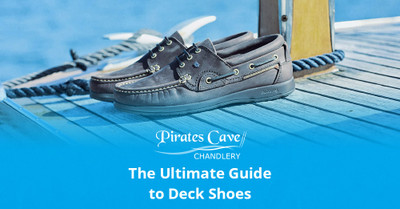29th Aug 2025
Deck shoes - often called boat shoes - are more than a classic look. They’re purpose‑built for wet, moving decks: non‑marking, high‑grip soles, salt‑resistant leathers, and low‑profile construction so you can feel the boat beneath your feet. The bonus? They’re versatile enough for the club bar, the pontoon, and weekend wear.
What Makes a Great Deck Shoe?
A great deck shoe combines three key qualities: grip, comfort and boat‑friendly construction. Outsoles should feature siping (razor‑cut channels) that disperse water and provide reliable traction on wet decks. Non‑marking rubber compounds protect gelcoat and timber, while flexible midsoles help you keep your balance on a moving boat.
Uppers are typically crafted from full‑grain or nubuck leather, which not only looks smart but also moulds to your foot over time. Traditional moccasin construction reduces pressure points, while 360° rawhide lacing allows you to secure the heel for a snug fit. Details like rust‑proof eyelets make a big difference in saltwater conditions.
Comfort comes from features such as cushioned leather or EVA footbeds, antimicrobial linings that keep odour at bay, and size options that suit both narrow and wide feet. Add to that a low‑profile silhouette, quick‑drying materials and neutral colourways, and you’ve got a shoe that works both on deck and ashore.
Sizing & Fit (UK‑Focused)
Most men’s and women’s deck shoes run true to size, though if you’re between sizes it’s often best to go half a size down since leather tends to stretch with wear. For sock‑free wear, choose a snug fit initially. Those with wide feet should look for models labelled as “wide fit” or designed with a more generous toe box. If you wear orthotics, go for models with removable footbeds or size up slightly.
Brand Snapshot: Chatham, Dubarry & Orca Bay
Chatham (British Heritage, Everyday Value)
Chatham deck shoes are ideal for day sailors, motor‑boaters and anyone wanting a classic look at a sensible price. Their blend of British design, durable leathers and dependable non‑marking rubber outsoles makes them a trusted first choice. You’ll find staple colours like navy, tan and walnut, available in both men’s and women’s sizes. With prices typically between £100 and £140 (as of August 2025), they’re a smart all‑rounder for coastal cruising or smart‑casual wear ashore.
Dubarry (Irish Premium, Technical Craft)
Dubarry offer a premium take on deck shoes. Known for luxurious leathers, rust‑proof hardware and razor‑siped soles, Dubarry deck shoes are built for sailors who spend serious time on deck. They’re as durable as they are stylish, with smart designs that work equally well for travel or office‑casual wear. Expect them to cost more, but also to last longer and age gracefully.
Orca Bay (Hand‑Finished, Great Fit)
Orca Bay sit between value and premium, offering hand‑finished shoes with superb comfort straight out of the box. Their soft leathers and cushioned footbeds make them popular with sailors who want easy break‑in and a slightly roomier fit. Orca Bay deck shoes are reliable, durable and usually more affordable than premium alternatives, making them a great choice for relaxed cruising and all‑day marina wear.
Which Deck Shoe Should You Choose?
If you’re buying your first pair of deck shoes, Chatham offers great all‑round value. For a step up in finish and durability, Dubarry may be the premium choice. If comfort and a slightly wider fit are your priority, Orca Bay should be at the top of your list. Those spending long hours on deck will appreciate Dubarry’s grip and support, while shoreside wearers may prefer the versatility of Chatham or Orca Bay.
Styling Tips (On Deck & Ashore)
Deck shoes pair effortlessly with technical shorts or chinos. Roll your hems to avoid wet cuffs, and go sockless for the traditional look or choose low‑cut no‑show socks for extra comfort. Neutral tones like navy, tan and chocolate ensure they’ll match your sailing gear as well as your casual wardrobe.
Frequently Asked Questions
Are deck shoes waterproof?
Deck shoes are not fully waterproof. They are made from water-resistant leathers that can handle splashes, spray and the occasional dunking, but they won’t keep your feet dry in heavy rain or if you step into a puddle. What they do offer is quick drying capability and salt resistance, which makes them ideal for fair-weather sailing, marina life and casual coastal wear. For serious offshore sailing or wet weather, you’ll need a pair of fully waterproof sailing boots.
Do deck shoes work on teak and GRP?
Yes. The soles on deck shoes from brands including Chatham, Dubarry and Orca Bay are designed specifically for boat use. They feature siping (razor-cut channels) that grip wet decks and non-marking rubber compounds that won’t scuff teak or GRP surfaces. This makes them a safe option for protecting both your boat and your footing.
Can you wear deck shoes without socks?
Absolutely, in fact many people do. Deck shoes are designed for barefoot or sockless wear, with breathable linings that reduce moisture build-up. If you want extra comfort, opt for no-show socks that wick sweat without spoiling the traditional look. To keep them fresh, rinse occasionally with clean water and allow them to dry naturally. Leather conditioner will also help prevent salt from drying out the leather.
How long do deck shoes last?
The lifespan of deck shoes depends on how often you wear them and how well you care for them. A pair used lightly through the summer months and cared for properly can last for years. If you’re wearing them daily on deck, you may see faster wear on the soles, but regular rinsing, conditioning and careful storage can add seasons of life. Premium leathers, like those used in Dubarry shoes, tend to age more gracefully, developing a patina rather than looking worn out.
Are men’s and women’s deck shoes different?
The main difference lies in fit and style. Women’s models are built on lasts shaped to suit female feet, often slightly narrower with a different arch profile, and are available in a wider variety of colours. Performance features - such as non-marking soles, siped grip and durable stitching - are the same across men’s and women’s ranges.
Do deck shoes stretch?
Yes, leather deck shoes generally stretch slightly as they mould to your feet. This is why many sailors recommend buying a snug fit to begin with, especially if you plan to wear them without socks. Over time, the leather softens and shapes itself to your foot, making them even more comfortable.
Why Buy from Pirates Cave
We've been selling a leading range of men's deck shoes, women's deck shoes and sailing boots for over 30 years. We offer fast shipping (next day as standard - subject to stock availbility), easy returns, and genuine advice from staff who sail. Our pricing is competitive across the range, and our 6,000 square ft Rochester store gives you the chance to try before you buy.



